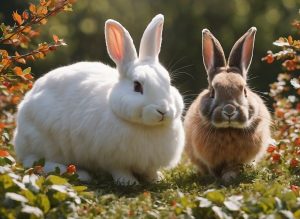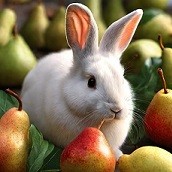Can Rabbits Eat Hawthorn Leaves, Twigs, Bark & Berries? Safe Diets, Preparation, Nutritional Value & Quantity
Attention Rabbit Lovers:

If you’re reading this, you’re probably just like me—a doting pet parent looking for the best and healthiest
1. The Curious Case of Hawthorn Leaves: Green Goodness or Hidden Danger?
Hawthorn
How to Prepare:
Wash the leaves thoroughly, ensuring they are free from pesticides and contaminants. You can offer these as a fresh treat.
Nutritional Value:
Hawthorn leaves are rich in antioxidants. While they might not serve as a primary food source, they’re a good supplement to your rabbit’s diet.
Recommended Quantity:
A few leaves a couple of times a week is enough. Remember, variety is crucial in a bunny’s diet.

References:
- 1 https://rabbitinform.com/can-rabbits-eat-hawthorn-berries/
- 2 https://food4buns.com/products/hawthorne-flowers-and-leaves
- 3 https://www.rabbitcaretips.com/things-that-rabbits-shouldnt-chew/
2. Twigs & Branches: A Natural Chew Toy?
Let’s face it, rabbits love to chew. Offering them twigs and branches can not only serve as a treat but can also help in wearing down their continuously growing teeth. Hawthorn twigs? A double win.
How to Prepare:
Clean the twigs of any residual sap. Remove any sharp or broken ends.
Nutritional Value:
While not nutritionally dense, they serve as a great dental aid.
Recommended Quantity:
Offer a twig once every week. Make sure it’s of an appropriate size, neither too big nor too small.
| Feature | Description | References |
|---|---|---|
| Twigs and Branches | Rabbits can chew on hawthorn twigs and branches for dental health, but they should not be the main source of nutrition. | 2, 3 |
| Preparation | Before feeding hawthorn twigs and branches to rabbits, they should be washed thoroughly to remove any dirt or pesticides. | 2 |
| Quantity | Hawthorn twigs and branches should be given in small amounts as part of a varied diet. | 2 |
| Nutritional Value | Hawthorn fruit is hypolipidemic in rabbits fed a high cholesterol diet, meaning it can help lower cholesterol levels. | 1 |
| Toxicity | Some woods, such as cedar, pine, elder, and oak, are toxic to rabbits and should be avoided. Hawthorn wood is safe for rabbits to chew on. | 3 |
References:
- 1 https://pubmed.ncbi.nlm.nih.gov/11773500/
- 2 https://www.rabbitcaretips.com/can-rabbits-eat-hawthorn/
- 3 https://www.rabbitinform.com/can-rabbits-eat-hawthorn-berries/
3. Bark & Trunk: The Unconventional Snack
Here’s where things get a bit controversial. Hawthorn bark is not a typical food item for bunnies. While not toxic, it doesn’t offer any substantial nutritional benefit.
How to Prepare:
If you’re considering giving bark, ensure it’s clean and free from mold or fungi.
Nutritional Value:
Minimal. It’s more for the chewing experience than nutrition.
Recommended Quantity:
This should be a very occasional treat. Maybe once a month or even less.
| Feature | Description | References |
|---|---|---|
| Safe for Rabbits | Hawthorn bark is safe for rabbits to eat. | 1 |
| Preparation | Thoroughly dry and sanitize the bark before offering it to your rabbit. | 1 |
| Nutritional Value | Hawthorn bark is a good source of fiber for rabbits. | 1 |
| Quantity | Offer small amounts of hawthorn bark as a treat, not as a main part of their diet. | 1 |
| Other Safe Woods | Willow, hazel, birch, spruce, maple, and fir are also safe for rabbits to chew on. | 1 |
References:
1 https://www.rabbitcaretips.com/things-that-rabbits-shouldnt-chew/
4. Berries: The Tangy Treat
Hawthorn berries are the fruit of the tree. They’re tangy, slightly sweet, and loaded with benefits. But can rabbits have them?
How to Prepare:
Clean the berries thoroughly. Offer them raw.
Nutritional Value:
They’re a good source of antioxidants, beneficial for the heart and overall health.
Recommended Quantity:
One or two berries once a week. They’re a treat, not a main food source.
| Feature | Description | References |
|---|---|---|
| Safe for Rabbits | Hawthorn berries are non-toxic to rabbits and can be eaten safely. | 1, 2 |
| Preparation | Before feeding hawthorn berries to rabbits, they should be washed thoroughly to remove any dirt or pesticides. | 1 |
| Nutritional Value | Hawthorn fruit is hypolipidemic in rabbits fed a high cholesterol diet, meaning it can help lower cholesterol levels. | 3 |
| Quantity | Hawthorn berries should be given in small amounts as part of a varied diet. | 1 |
| Treats | Hawthorn berries can be used as a treat for rabbits, chinchillas, guinea pigs, and other small pets. | 6 |
References:
- https://rabbitinform.com/can-rabbits-eat-hawthorn-berries/
- https://www.harcourt-brown.co.uk/media/collections/diet/foraging/favourite-plants/hawthorn-with-berries/view
- https://www.ncbi.nlm.nih.gov/pmc/articles/PMC8659235/
- https://fuzzieskingdom.com/herbs/treats/hawthorn-berries-chinchilla.html
The Crucial Balance: Moderation and Variety
One thing I can’t stress enough is balance. Just like we wouldn’t eat the same food every day, our bunnies crave variety. While hawthorn components can be a great addition to their diet, they should complement their main diet of
Wrap-Up: Hawthorn – A Friend or Foe?
In the vast world of rabbit diets, hawthorn stands out as a multifaceted plant. Leaves, twigs, bark, or berries – each component offers something unique. While it’s exciting to introduce new foods to our bunnies, always be cautious. Start with small quantities, monitor your rabbit’s reaction, and always ensure the hawthorn is free from pesticides or other chemicals.
For anyone looking for a final verdict: Yes, hawthorn, in its various forms, can be a delightful addition to your bunny’s diet. But, as always, moderation is key.
Stay curious, keep exploring, and give your furry friend that extra hug from me. Stay tuned for more deep dives into the intriguing world of rabbit nutrition.







Leave a Reply